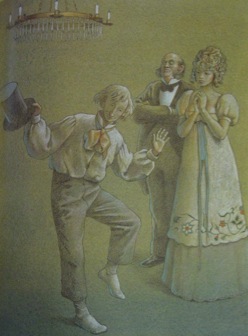
Interview with Jane Yolen
Erin Daly and Daniella Bordonaro visited Jane Yolen at her home in Hatfield to talk about writing, The Perfect Wizard, and what’s next for this prolific author.
Erin Daly: Can you talk a little bit about how The Perfect Wizard came together?
Jane Yolen: This is the third book that Dennis and I did together, maybe the fourth. For years I’d been called the Hans Christian Andersen of America and Hans Christian Andersen’s major birthday was coming up in a few years when Stephen Meltzer, an editor at Dutton I’d never worked with before sent my agent a letter asking if I might be interested in writing a picture book of Andersen’s life. I said of course. I mean, who better? (She says humbly!) So I started reading everything I could get my hands on.
Andersen had written an autobiography, but like everything he wrote about his life, he made up a lot of it. So I had to find out other stuff about him, books other researchers had written. I worked on that for probably half a year. Did several revisions for the editor who asked piercing questions. It was really, in some ways, one of the smoothest and easiest books I have ever
ever done. Once I had figured out how to do it that is. I decided to use bits and pieces of his stories, a line or two—he had hundreds of stories, that slotted right into his life and it was easy because he really wrote fairy tales that were almost little autobiographies, little snatches of his life disguised as fairy tales. Some picture books take years and years to do. They can be harder than novels to write because of the need for compression and the lyrical line and also the author has to be sure that they’re emotionally accessible to the child reader. But this one just seemed to write itself.
Then the editor and I started thinking about an illustrator and I don’t remember if he came up with the idea of Dennis or I did. I think he did, but since I had worked with Dennis before and I know Dennis quite well because we live in the same area, I thought that was a great choice.
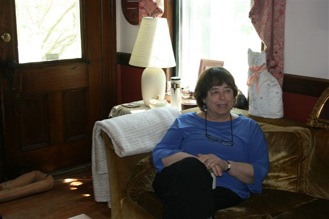
Erin Daly: In general what is it like working with illustrators? Often authors don’t get to meet the illustrators they are working with, but you seem to know a lot of them.
Jane Yolen: I have done well over a hundred picture books and I would say that about half of them I knew the illustrator ahead of time and with the other half, not only I do not know the illustrator, in about a quarter of them I’ve never met the illustrator to this day. Which is odd because I go to a lot of conferences where illustrators go. But at least I write to many of the ones I haven’t met to say how much I love their work. And I do.
Because I knew Dennis, it was a very different kind of working relationship. He sent me some of the early work to look at, and I loved what he was doing. What he was doing looked very much like an old-fashioned book. The book is all in subtle, muted tones that make it look as if it could have been a book first published in an old rotogravure newspaper with that kind of brownish tinge. So, it was just exciting to see what he was doing. But I never felt shut out of the process. There are, of course, illustrators who really don’t want the author involved. You become an annoyance or you become and intrusion or you become a game changer for them when they don’t want the game changed. For example, Dennis and Jane Dyer and Ruth Sanderson, all local illustrators, have always invited me into the process. Barry Moser-- when we did a book together--said, “I’ll call you when the thing is finished.” And that’s fine, that’s the way he works. He doesn’t want someone looking over his shoulder and is not comfortable with it. And another illustrator I know is Brian Froud, who lives in England. He won’t even let his wife into his studio. When his pictures are done and if you happen to be visiting, which I was, he says, “Now sit in the living room,” and I sat there with his wife and his son. and he brought out the pictures because he doesn’t want anyone intruding in the process of his art. It’s too personal a thing for him. But others like, like Jane Dyer and Dennis like Ruth Sanderson are perfectly willing to have authors they trust come to their studios to see what they’re doing And sometimes they will even ask, “What do you think of this.” Since I’ve been an editor who worked closely with both illustrators and art directors, I know how to talk to then, I always start by saying, “Oh this is great, I love this.” Because I wouldn’t want somebody looking over my shoulder saying, “Oh you’ve got to do this, you’ve got to do that.”
Erin Daly: When we were talking with Dennis he said that because you’ve been an editor and you’ve done a lot of picture books that you might have some say in which illustrator you work with? How does that work?
Jane Yolen: Rarely, rarely, can I choose. I can suggest. Occasionally – now I just had an agent in the same agency as my agent, send me some pictures that one of her illustrators had done. Now I’d done two books with that illustrator. She has these three pictures marvelous pictures, one is of a wolf with it’s arm up as if he’s volunteering for something. One of a sheep who’s knitting directly from its own wool. And one is a king who’s a crocodile, dressed all in kingly robes and his two dancing daughters, who are also crocodiles obviously, wearing ballet tutus. So I worked on a book called the Wolf With an Arm on a Hinge because my mother always said that I had an arm on a hinge, meaning I volunteered for everything. But all three of us, agent, illustrator, and I all know, that it’s harder to sell a book with an illustrator already attached. So we’re trying this, seeing if this will work. If it doesn’t, the illustrator will go her way and I’ll go my way, and I’ll have this picture book text that I will be allowed to dell without her pictures. Illustrators, if they don’t write, have to wait for somebody to call them up and say, “I’ve got a great book, will you do it?” Dennis does write some of his own, so at least he has that.
Erin: We’re wondering do you have a favorite page from the finished version of the book?

Jane Yolen: Andersen went to school at a much older age than others and he did not get along with his teachers. Yeah I think those three are my favorites. This one: where he’s totally overwhelmed. This one: where he’s dancing for the ballerina. And the one where’s he’s going off to school with the other school children and the difference – he was big and tall and scraggly anyway, but compared to the boys whose class he was in, a giant. And the schoolteacher is there with his arms closed; he was a nasty piece of work. Those are my three favorite. But I love these little vignettes, in which you see characters from the stories. And of course, there I am in this photograph on the back flap of the book, sitting on the lap of the statue of Andersen when I was in my early twenties.
Erin Daly: Where is that statue?
Jane Yolen: In New York City
in Central Park.
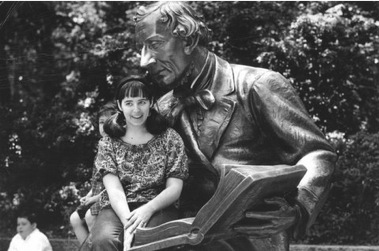
Erin Daly: Is there anything else about Andersen’s life that you felt connected to or that inspired you?
Jane Yolen: Andersen was a very strange man. He grew up in a very strange family. His mother was illiterate. His father was literate but didn’t live very long. Andersen was still a boy when his father died. His mother filled his head with fairy tales, many of them very dark. He had a sister who was probably a prostitute and a grandfather who was mad, who would wander around with leaves in his hair talking to birds and trees. So his family was very dysfunctional. And his mother was convinced that he was a genius, so when he said he wanted to go to Copenhagen to become a poet–even though he hadn’t had a lot of schooling—his mother] gathered together enough money to send him by cart to Copenhagen and also managed somehow to get him an introduction to someone in the theatre. He arrived—barely out of boyhood, a young teen, with just a few copper coins and everything he owned in a bundle and basically bulled his way into a place in the theatre school. They decided, on absolutely no real credentials, that he really had some kind of talent and they let him be in a few of the plays. He had no dancing ability, but they gave him a few roles and then they decided that he was not going to get anywhere unless he had some real education so they sent him off to an actual elementary school even though he was a teenager. And that’s where he got a modicum of education. The first book he wrote, he printed himself, so probably he sold half a dozen copies and the rest were trashed and were used for paper to wrap cheese in. But when he started writing fairy tales, that’s when his life as a writer really started taking off. He became so worldwide famous that he started to have correspondences with famous writers like Charles Dickens. In fact, Dickens said to him, sort of in passing at one point, “If you’re ever in England please come for a weekend.” Well he went to England and he ended up staying for over a month until Dickens’ children begged their father to throw him out because the only thing he liked to do was talk about himself and he didn’t speak English all that well and he would just make the children sit still and talk at them in his broken English or read them his stories and poems in Danish.
So he was not an easy person. He probably remained a virgin all his life. Not from lack of trying. But he always fell in love with celebrities. He fell in love with Jenny Lind the Swedish Nightingale, who sang in Northampton, MA. She said “you’re a very nice man and we can be friends.” Then, he wrote the Emperor’s Nightingale about her. He fell in love with a ballerina, then wrote a story about a ballerina made of paper. who loved the one-legged tin soldier.
He may have been in love with his best friend; he may have been in love with a male ballet dancer, but in those days it would have taken a very strong personality to be able to follow that path. These days he might have been able to come out, bit it was his repressions as well as his obsessions that made him the great fairy tale writer that he was
He really did not lead a whole and wholesome life. Though when he wrote his autobiography he started out saying: “My life is a fairy tale. Everything is beautiful and wonderful.” So, I don’t think he ever looked very deeply into his heart and soul.
Daniella: Did you ever read The Perfect Wizard to kids?
Jane Yolen: When it first came out, I did. But I write so much that when a book is done for me, it’s done. Except at readings, where I people always want to hear Owl Moon, How Do Dinosaurs Say Goodnight, and the latest book whatever it is, I don’t read past books. But when do when a book is when it’s newly out and then I do that for half a year or a year and then it sort of fades for me, and I move on to something else. So that’s why I had to look through he book to remember it, because this book as been around for quite some time. It’s backlist [gestures as if backlist is a place in her mind].
Erin: Is doing a nonfiction picture book a lot different than doing a fiction picture book or something longer?
Jane Yolen: First of all picture books and novels are very different. Sometimes picture books are a lot harder because every word has to be right. With a novel you can lose whole paragraphs and not notice. Nonfiction picture books, of which I’ve done quite a few, take as much research as if you were going to write a huge book. Because you have to, after you’ve done all that research, boil it down to the essentials and try to find a way into the story that’s going to be accessible to children and can be told in very few words and that’s hard. It’s easier to start fresh with fiction in a picture book. It doesn’t have to be tied to anything.
I just finished two books The very difficult one is about Honus Wagner the greatest shortstop that baseball has ever had, and he did it all without drugs. It was difficult because there’s a man’s whole life and possibly only real baseball fans would be interested in so first I had to decide how much of the real baseball stuff could I put in a book for 5-6-7-8 year olds. Then I just finished a manuscript on a part of Benjamin Franklin’s life, but it’s really now about his son and what was known as the Leather Apron Club. Benjamin Franklin started a philosophical club for men all of whom in their jobs wore leather aprons--or most of them did. There were 12 men in it originally and they ended up creating the first lending library in America. But to make the story emotionally accessible to child readers, I had to write it from the boy’s point of view and he was too young to be a member of the club. Therefore the book had to be about his relationship with his stepmother and his father and his cousin and his surroundings. And then one day, he had to be invited by his father for some reason to go to the club’s library and that reason was he had gone from being a very wild kid with his cousin to being a kid who loved books. He became obsessed with books and he ended up Governor of NJ and he also was a Tory and so when the revolution came, he and his father broke ranks because Franklin, of course, was very involved with the starting of the United States of America. And His son was loyal to the king and moved to England where he lived for the rest of his life and they only met once more after that. So those sorts of things – that’s a lot to try and squeeze into a book that’s going to be less than 40 pages.
Erin: What is the research process like for something like that? It sounds like you know a lot of details.
Jane Yolen: You have to. If the person themselves has written anything you start there. Or I usually start with an overview a short overview whether it’s an encyclopedia or someone else’s book about Franklin that’s where I start, just to get a kind of quick overview. And then I start saying all right, what things do I have to get really into. Franklin wrote a lot, so there’s that, but this part of his life—where the son was probably the child of a prostitute and Franklin before he was married and he took the child and his wife, when he got married, had to raise the boy. She never liked him. So that’s interesting and you have to get it in but subtly. And then the boy ran wild in the streets with his cousin who lived with them and so that has to be in the book, but done in a way that makes it sound not nasty wild, but sort of charming. They boys were both supposed to be working, Will helping his Dad in the print shop and the cousin in a shop where they sold the stuff that was printed, but also other stuff, that the stepmother took care of. To show the boys tearing off their leather aprons and racing out because it’s much more fun to be in Philadelphia where everything happens. So those sorts of things begin to open up the story. And the same thing with Andersen’s life: I had to hit the boy stuff first. Show him with his father reading to him, his mother telling him stories, the death of the father. Then there’s all the adolescent stuff when he goes off to Copenhagen to become a famous poet and theatre person and yet was still a boy. I didn’t want to do that much with him as an adult and as an old man because the child reading the book wants to see the boy, wants to compare himself/herself to the boy.
The secret of the successful picture book biography is just that: seeing the older more competent and successful person in the child. Showing that child develop past difficulties into the amazing adult we admire. I hope I have done that with The Perfect Wizard.
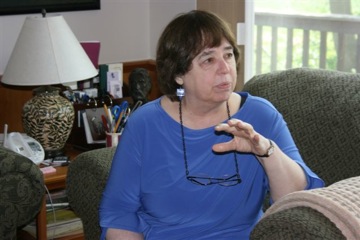
Jane Yolen: Yes...[looking through the book]. Seeing these all over again is wonderful. I’m very fond of this one [Andersen in street], because you just get the sense of this gawky individual very much apart from the people and absolutely overwhelmed by the big city. It’s quite a lovely picture. He’s really alone. And this is fun because of the situation where Andersen, and started dancing for her though he was totally untrained. He just said, “Let me dance for you.” He would go up to people in the streets and tell them his poems, just stop strangers. He was a very odd sort of man. Now this is the picture that I have and I’m very fond of it.
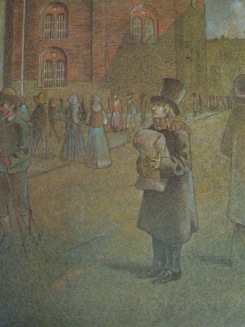
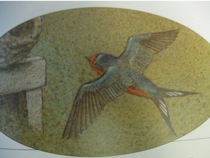
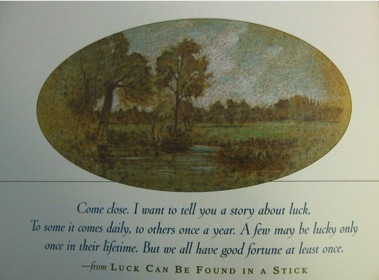
photo by Daniella Bordonaro
photo by Daniella Bordonaro
photo by Daniella Bordonaro
photo by David Stemple
